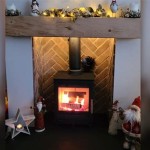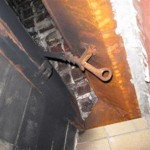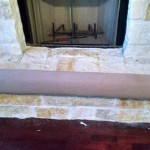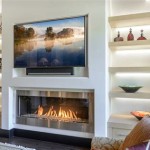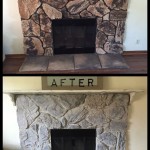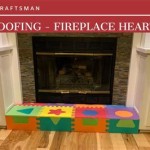Understanding Fake Fireplace Gas Heaters: Aesthetics, Functionality, and Considerations
Fake fireplace gas heaters, also known as ventless or vent-free gas fireplaces, have emerged as a popular heating solution, offering a semblance of the traditional fireplace without the requirements of a chimney or venting system. These appliances utilize natural gas or propane to produce heat, and their primary appeal lies in their ability to mimic the aesthetic qualities of a real wood-burning fireplace. However, a comprehensive understanding of their functionality, safety considerations, and regulatory aspects is necessary for informed decision-making.
The term "fake" can be misleading, as these heaters are genuine heating appliances that burn fuel to generate warmth. The "fakeness" primarily refers to the simulated flame effect and the absence of traditional venting. Unlike conventional fireplaces that require a chimney to expel combustion byproducts, ventless gas fireplaces are designed to burn fuel more completely, theoretically minimizing the production of harmful emissions. The intended outcome is that the exhaust, primarily carbon dioxide and water vapor, is released directly into the room. This efficiency allows for near 100% heat transfer into the space, contributing to their popularity as a supplemental heating source.
The design of fake fireplace gas heaters encompasses a variety of styles, ranging from freestanding units resembling traditional wood stoves to inserts designed to fit within existing fireplace openings. Many models feature realistic-looking artificial logs, ember beds, and flame patterns, designed to replicate the ambiance of a real fire. The level of realism varies depending on the quality and sophistication of the design. Some units even include remote controls for adjusting flame height, heat output, and blower fan speed. The aesthetic appeal is undoubtedly a significant factor driving their adoption, particularly in homes where installing a conventional fireplace is impractical or cost-prohibitive.
The operation of a fake fireplace gas heater is relatively straightforward. Upon ignition, gas flows to a burner, where it mixes with air and combusts, producing heat. The heat then radiates outwards, warming the surrounding space. Many models incorporate a blower fan to circulate the heated air more effectively. The burner assembly is typically housed within a firebox, which is designed to contain the flames and direct the heat outwards. Safety features are integrated into the design, including oxygen depletion sensors (ODS) and automatic shut-off mechanisms.
Key Point 1: Functionality and Efficiency
The functionality of a fake fireplace gas heater hinges on its ability to efficiently convert fuel into heat. The absence of a vent means that all the heat produced remains within the room, resulting in a high thermal efficiency rating. This can translate into lower heating costs compared to traditional fireplaces, which lose a significant amount of heat through the chimney. However, the efficiency is dependent on proper installation, maintenance, and operation. Regular cleaning and inspection of the burner assembly are crucial for maintaining optimal performance. Additionally, ensuring adequate ventilation in the room is essential for preventing the build-up of potentially harmful gases.
The heating capacity of a fake fireplace gas heater is typically measured in British Thermal Units (BTUs). The appropriate BTU rating for a particular room depends on factors such as the room's size, insulation, and climate. Selecting a heater with an appropriate BTU rating is important for ensuring efficient and comfortable heating. An undersized heater may struggle to adequately warm the space, while an oversized heater may cycle on and off frequently, leading to uneven heating and energy waste. It is generally advisable to consult with a qualified HVAC professional to determine the optimal BTU rating for a specific application.
The control mechanisms of these heaters often include a thermostat, which allows for precise temperature regulation. Some models offer programmable thermostats, enabling users to set specific heating schedules. This can further enhance energy efficiency by automatically adjusting the heat output based on occupancy and time of day. The use of remote controls provides added convenience, allowing users to adjust the settings from a distance. The functionality of the control system contributes significantly to the overall user experience and efficiency of the heater.
The reliability of a fake fireplace gas heater is dependent on the quality of its components and the diligence of its maintenance. Regular inspections and cleaning can help prevent malfunctions and extend the lifespan of the appliance. Component failures, such as a faulty igniter or a malfunctioning gas valve, can disrupt the heater's operation. Prompt diagnosis and repair of such issues are essential for maintaining safe and efficient heating.
Key Point 2: Safety Considerations and Regulations
Safety is paramount when considering the use of fake fireplace gas heaters. Although designed to burn fuel cleanly, these appliances still produce combustion byproducts, including carbon dioxide, water vapor, and trace amounts of other gases. Adequate ventilation is crucial for preventing the build-up of these gases to potentially harmful levels. The Oxygen Depletion Sensor (ODS) is a critical safety feature that automatically shuts off the heater if the oxygen level in the room drops below a safe threshold. This helps to prevent carbon monoxide poisoning, a serious health hazard.
Carbon monoxide (CO) is a colorless, odorless, and tasteless gas that can be fatal if inhaled in sufficient quantities. It interferes with the body's ability to transport oxygen, leading to symptoms such as headache, dizziness, nausea, and loss of consciousness. Because CO is undetectable by human senses, the ODS is essential for providing an early warning of potentially dangerous conditions. Regular testing of the ODS is recommended to ensure its proper functioning. Carbon monoxide detectors should also be installed in the home to provide an additional layer of protection.
Regulations governing the use of ventless gas fireplaces vary depending on the jurisdiction. Some areas may have restrictions or outright bans on their use due to concerns about indoor air quality and safety. It is essential to check local building codes and regulations before purchasing and installing a fake fireplace gas heater. Compliance with these regulations is crucial for ensuring the safety of the occupants and avoiding potential legal consequences. Many jurisdictions require professional installation of gas appliances to ensure proper safety and compliance.
Proper installation is crucial for ensuring the safe and efficient operation of a fake fireplace gas heater. The appliance should be installed by a qualified technician who is familiar with the manufacturer's instructions and local building codes. The installation should include proper gas line connections, ventilation considerations, and clearance requirements from combustible materials. Incorrect installation can lead to gas leaks, fire hazards, and carbon monoxide poisoning. Regular inspections by a qualified technician are also recommended to ensure the continued safe operation of the appliance.
Key Point 3: Maintenance and Longevity
The longevity and optimal performance of a fake fireplace gas heater are contingent upon regular maintenance. This includes routine cleaning of the burner assembly, inspection of gas lines and connections, and testing of safety features such as the ODS. Dust and debris can accumulate on the burner, hindering efficient combustion and potentially leading to incomplete burning of fuel. Cleaning the burner with a soft brush or vacuum cleaner can help remove these contaminants and restore optimal performance. It is crucial to follow the manufacturer's instructions for cleaning and maintenance procedures.
Inspecting gas lines and connections for leaks is essential for preventing gas leaks, which can pose a significant fire hazard. A simple soap and water test can be used to detect leaks. Apply a soapy solution to the gas line connections and watch for bubbles, which indicate a leak. If a leak is detected, immediately turn off the gas supply and contact a qualified technician to repair the leak. Regular inspection of gas lines can help prevent potentially dangerous situations.
The lifespan of a fake fireplace gas heater can vary depending on the quality of the appliance and the diligence of its maintenance. With proper care, these heaters can provide many years of reliable service. However, component failures can occur over time, requiring repairs or replacements. Common issues include faulty igniters, malfunctioning gas valves, and worn-out blower fans. Promptly addressing these issues can help prevent further damage and extend the lifespan of the heater.
The cost of ownership of a fake fireplace gas heater includes the initial purchase price, installation costs, fuel costs, and maintenance expenses. The initial purchase price can range from a few hundred dollars to several thousand dollars, depending on the size, features, and quality of the appliance. Installation costs can vary depending on the complexity of the installation and the rates charged by the installer. Fuel costs depend on the price of natural gas or propane and the frequency of use. Maintenance expenses include the cost of cleaning supplies, replacement parts, and professional service calls. A comprehensive assessment of these costs is necessary for making an informed decision about purchasing and using a fake fireplace gas heater.

Electric Fireplaces A Safe Alternative To Gas Touchstone Home S Inc

Gas Log Fires Artificial Fireplaces Fake Stone

Gas Log Fires Artificial Fireplaces Fake Stone

Vintage Mantle With Gas Heater Repurposed Propane Wall Heaters Fake Fireplace

Vented Gas Logs Heater Or Decorative Bart Fireside

ᑕ❶ᑐ An Electric Fireplace As A Heater Pros Cons

Are Electric Fireplaces Energy Efficient We Love Fire

Custom Made Fireplaces Lopi

9 Best Electric Fireplace Inserts Of 2024 Tested And Reviewed

Gas Fires Fireplaces Log Rinnai
Related Posts


